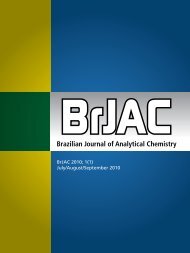Brazilian Journal of Analytical Chemistry - BRJAC - Brazilian Journal ...
Brazilian Journal of Analytical Chemistry - BRJAC - Brazilian Journal ...
Brazilian Journal of Analytical Chemistry - BRJAC - Brazilian Journal ...
You also want an ePaper? Increase the reach of your titles
YUMPU automatically turns print PDFs into web optimized ePapers that Google loves.
Br J Anal Chem 2011, 03, 131–135<br />
ClosEd-vEssEl m iC r o w a v E-assistEd d i gE s t i o n u s i n g<br />
a d i l u tE d o x i d a n t m i x t u rE f o r traCE ElEmEnt<br />
d E t E r m i n a t i o n in PEtroChEmiCal samPlEs By axiallyviEwEd<br />
iCP oEs<br />
an g E r s o n n. nasCimEnto a , Ju l i a n a na o z u k a B , PE d ro v. olivEira a *<br />
A) Instituto de Química, Universidade de São Paulo, 05508-000 - São Paulo, SP, Brazil<br />
B) Centro de Ciências Naturais e Humanas, Universidade Federal do ABC, 09210-170 - Santo André, SP, Brazil<br />
*Corresponding author:<br />
PV Oliveira/Phone: + 55<br />
11 3091 8516 / e-mail:<br />
pvolivei@iq.usp.br<br />
www.brjac.com.br<br />
ab s t r a c t<br />
A simple, robust and reliable analytical method for the determination <strong>of</strong> metals (Ag, Al,<br />
Ba, Ca, Cd, Cr, Cu, Fe, Mg, Mn, Mo, Na, Ni, Pb, V and Zn) and nonmetals (P and S) in<br />
petrochemical samples (petroleum, diesel oil, biodiesel, and oil sludge waste) by axiallyviewed<br />
inductively coupled plasma optical emission spectrometry (ICP OES) is proposed.<br />
A diluted oxidant mixture (4 mL HNO 3 + 2 mL H 2 O 2 + 2 mL H 2 O) was used to achieve<br />
almost complete oxidation <strong>of</strong> the organic matrix in a closed-vessel microwave oven. The<br />
residual carbon (3-9 % w/w) supported the effectiveness <strong>of</strong> the sample digestion with<br />
the diluted oxidant mixture. The accuracy <strong>of</strong> the analytical method was confirmed by<br />
analysis <strong>of</strong> a standard reference material (residual oil - NIST SRM 1634c) and another<br />
reference material (hydrocarbon oil - Alfa Aesar JM-21). The reference values showed<br />
good agreement at a 95% confidence limit (Student’s t-test).<br />
Ke y w o r d s : petroleum, diesel oil, biodiesel, sludge waste, ICP OES, diluted oxidant<br />
mixture, microwave<br />
In t r o d u c t Io n<br />
The development <strong>of</strong> analytical methods for elemental<br />
determination in petrochemical products has been<br />
arousing interest, mainly due to their prominence, in<br />
terms <strong>of</strong> quality control, economics and environmental<br />
factors [1-3]. Crude oil contains several metals as organometallic<br />
complexes and information on these trace<br />
elements is important for geological (crude oil origin)<br />
[4,5] and environmental studies (anthropogenic emission<br />
<strong>of</strong> petroleum-based fuels) [6,7]. The poisoning <strong>of</strong><br />
catalysts in the petroleum cracking process and corrosion<br />
<strong>of</strong> equipment, owing to the presence <strong>of</strong> these<br />
trace metals in oils, has also been widely reported [8,9].<br />
Therefore, with the exception <strong>of</strong> certain additives, it is<br />
desirable that petrochemical products have low metal<br />
concentrations, aiming at a highly sensitive and precise<br />
method for quality control and for emission controls <strong>of</strong><br />
these elements to the atmosphere.<br />
Elemental determination in petrochemical products<br />
by spectroscopic techniques is not easy, mainly because<br />
<strong>of</strong> the high complexity and organic nature <strong>of</strong> their matrix<br />
[1,10]. Despite this, inductively coupled plasma optical<br />
emission spectrometry (ICP OES) is the technique<br />
recommended by the American Society <strong>of</strong> Testing Materials<br />
(ASTM D 4951) [11] and the European Commit-<br />
tee for Standardization (CEN-EN 14 107) [12]. This analytical<br />
technique is a well-established multielementar<br />
one and presents a wide linear dynamic range, good<br />
analytical detectivity and high sample throughput [13].<br />
However, ICP OES usually requires the conversion <strong>of</strong> organic<br />
samples into a clear solution with low residual<br />
carbon content [14].<br />
In general, digestion procedures are useful for petrochemical<br />
samples as a pre-treatment before elemental<br />
determination by ICP OES [1]. Microwave-assisted<br />
sample preparation has been used for a wide range <strong>of</strong><br />
applications [15]. Sample preparation procedures using<br />
digestion with diluted oxidant mixtures are still little<br />
explored for petrochemical samples. Some favorable<br />
characteristics <strong>of</strong> the digestion with diluted reagents<br />
are low blank values, low standard deviations and less<br />
contamination. Particularly for ICP OES, it is important<br />
to point out the minimization <strong>of</strong> interferences caused<br />
by concentrated acids, mainly during sample nebulization,<br />
and the reduction <strong>of</strong> chemical attack on equipment<br />
parts, such as the nebulizer, nebulization chamber<br />
and torch [14]. Finally, this procedure promoted the application<br />
<strong>of</strong> clean analytical methods with low residue<br />
generation, and is economically viable due to its low<br />
131



